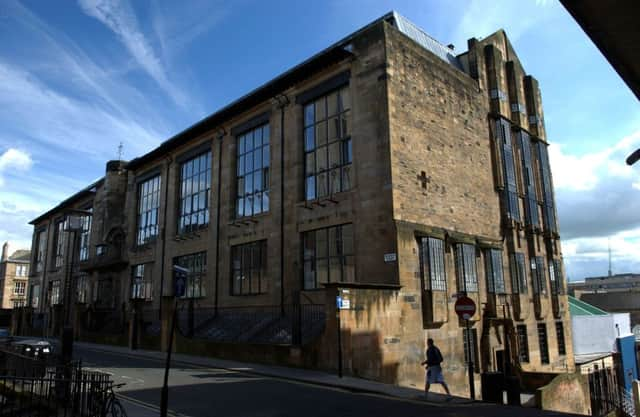The Mack should be rebuilt on love


Out we came from the nation’s substantial stock of sturdy inter-war council houses, comfortable enough, but often visually dull; and there on steep Garnethill stood this astonishing sandstone castle of light and imagination, dark corners and dreams, where young people from any class - if they were talented enough - could learn painting and drawing in spaces that helped transform their very sense of who they were, and what they could become.
My own educational journey took me elsewhere, into the more traditional academic world of English literature. On Garnethill, though, generations of Mack students were on a fast track to an instinctive understanding of Scotland - and Glasgow - as a place both traditional and modern, both steeped in its own history, and capable of the most brilliant and original reinvention. And above all, touched by influences that ranged from Scottish baronial architecture to the Vienna Secession, the Mackintosh building was beautiful - playful and radiant, as well as mindful of its heritage. By the 1980s, when Glasgow began to reinvent itself as a cultural capital after decades of industrial decline and devastation, Mackintosh was decisively back in fashion, his distinctive art-nouveau designs appearing on everything from table mats to key-rings. And as Glasgow changed, the Mackintosh building stood on, one of Glasgow’s mighty centrepiece buildings, and a working art school that embodied an essential part of the city’s creative spirit.
Advertisement
Hide AdStood on, that is, until the terrible fires of May 2014 and June 2018, the first bad enough, the second a cruel, complete and devastating conflagration that ravaged the almost-refurbished building within two hours, leaving nothing but smoke-blackened outer walls. Nor did the blaze come at a moment when Glasgow seemed well placed to cope with its consequences. After a decade of harsh cuts in local government across the UK, Glasgow City Council - like many elsewhere - now seems a weak and hesitant institution compared with its predecessors of the 1980’s and 90’s. The sense of momentum around some of Glasgow’s great cultural organisations of the 1990 era was lost long ago; and in 2015, notoriously, Glasgow Council, Creative Scotland and the Scottish Government all stood by and allowed the closure of the Arches under Central Station, one of the great, unique post-industrial venues opened in the 1990 period.
None of this means that Glasgow is culturally dead, of course. It remains a colossally vibrant and diverse city, packed - much more than overpriced Edinburgh can currently hope to be - with a huge range of young people seeking creative futures. It has brilliant music and visual arts scenes; and it is the home of the Royal Conservatoire of Scotland, as well as of all our national performing companies.
Yet there’s a sense that in a crisis, the city’s cultural scene now lacks an essential element of confident, forward-looking leadership; and given the scale of the GSA fire - which has had a devastating impact on local residents and businesses, destroyed the vital ABC music venue, and may yet threaten the survival of the Centre for Contemporary Art in Sauchiehall Street - it is now absolutely clear that a new era of well-focussed leadership is needed, to help Glasgow make good collective decisions about how to recover from this crisis, and how to make that recovery work in a way that wins the support of the whole city.
For already, it’s possible to see how anger over the fires, and over the inept and callous handling of their impact on local people and businesses, has begun to spill over into a feeling again the Mack itself, and against the idea of rebuilding it. Last week, the GSA Board made a firm decision to rebuild the building brick for brick, to Mackintosh’s plans; but no loud chorus of joy and approval greeted their announcement. This week, the Glasgow gallery owner Roger Billcliffe argued that even if the Mack is rebuilt, it should never again be left in the stewardship of Glasgow School of Art - even though, at the time of the second fire, it was the rebuilding contractors, and not the GSA directly, who were responsible for the safety of the building. And my guess is that this bitter argument about blame, responsibility, and who should in future be trusted with what, will rage on for months and years, far beyond the final report of the fire investigators.
Will rage on, in fact, until someone - or some organisation - steps up with a wider vision, and persuades everyone involved to start thinking creatively about a rebuilding of the Mackintosh Building that will capture its vital role in expressing and freeing the spirit of the city, and take that forward into the future. And that means that if the Mack is rebuilt - and I think Glasgow should try, should set itself the task of recreating this inimitable building for a new century - then it cannot be rebuilt in a meaningful way by the board of the GSA alone.
Instead, it should be rebuilt with the love of the city, as part of a wide-ranging city-centre cultural scene, and with the support of the kind of alliance - of council, government, business, artists, institutions and communities - that set about pulling Glasgow up by its bootstraps in the 1980’s, and making it the capital of culture it became. If that means rethinking the GSA’s relationship with the city to recreate a greater sense of connection with the Mackintosh Building, then that might be no bad thing, although it should always be a place for teaching art. And it is worth remembering - as we celebrate the current cultural energy of cities like Dundee and Liverpool - that Glasgow, 30 years ago, was the city that drew the road-map for 21st century cultural development; and that now needs to flex its mighty creative muscles, start shifting the obstacles in its path, and do it again.